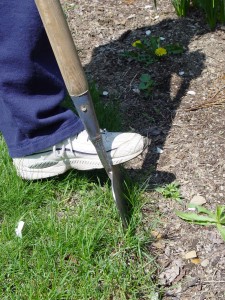Don’t Hurt Yourself
July 16th, 2013
I watched an interesting video the other day by Dan Buettner, a writer whose focus is on living longer (“The Blue Zone: Lessons for Living Longer from the People Who’ve Lived the Longest”).
One of the common denominators Buettner found in long-lived cultures is that the people tend to do a lot of natural moving in their day-to-day lives. And one of the most common activities is… gardening.
No surprise there. It’s great exercise, fresh air, great for relieving stress (except when groundhogs visit) and a source of fresh, healthy food.
But the garden is also a place of thorn punctures, bug bites, back strains, fence cuts, sun-burned balding heads and assorted other threats if you aren’t careful.
I’ve experienced all of those – sometimes in the same hour.
Not to scare you off, but in the interests of keeping as many readers as possible out of the ER this summer, I thought I’d share my top 9 gardener health pitfalls and how to avoid them:
* Back Trouble. This one’s the biggie because of all the bending and lifting of way-too-heavy things that gardeners tend to do.
Stretch before heading into the garden, use your knees and legs to lift, and don’t do bending activities hour after hour. Get help with the heavy stuff. Sit or kneel instead of bend. And knock it off when you’re tired.
* Falls and Cut-Offs. Tree legend Dr. Alex Shigo once said the world’s most dangerous combination is a homeowner, a ladder and a chainsaw.
Hire a trained, insured pro to do the high stuff. Read and follow safety instructions when you’re using cutting tools, and don’t do stupid things, especially when you’re tired.
The reason the lawn-mower user manual has 10 pages of precautions such as, “Not to be used for shearing hedges,” is because someone probably hurt himself trying to mow his yew bushes.
Also ditch the old shoes when they lose their traction.
* Repetitive Injuries. Carpal tunnel syndrome and just plain sore, achy hands and fingers can happen when you repeat forceful actions over and over.
Vary your jobs so you’re using different body parts. Sharpen those tools and shovels. You’ll be amazed at how easier the job becomes.
Don’t force things that aren’t happening under normal energy, such as jumping on the edging tool to get through the rocky soil. (My foot X-ray can vouch for this one.)
Use the right tool for the job, and look for ergonomic designs that keep pressure to a minimum.
* Eyes and Ears. Wear goggles if you’re using a chipper, weed-whacker or any tool that causes stuff to fly.
Also wear ear plugs when operating noisy power equipment such as leaf blowers, tillers and chipper-shredders.
An underrated eye threat is poking yourself on bamboo stakes when bending over to pick something. You can buy stake-toppers or rig up your own poke-preventers by securing plastic golf balls or split tennis balls on top of low stakes.
* Dehydration. Hours of work on a hot, sunny, humid day is the perfect storm for this condition, which can lead to muscle cramps, heat exhaustion and potentially fatal heat stroke.
Drinking more than you think you need is the best prevention. Two to 4 cups of water per hour while you’re working in the heat is recommended.
Wear light-colored, loose-fitting clothing and take breaks.
* Tetanus. This is a bacterial infection that can cause muscle spasms, seizures and an 18-percent death rate. It’s nothing to mess with.
About one-third of reported cases stem from yard work, such as getting pierced by a thorn, getting cut by a fence or getting punctured by a splinter.
A tetanus booster shot will practically eliminate the risk. “Normal” people should get one every 10 years, but my trusty doc says that obsessed gardeners like myself should get one every 5 years.
Wearing gloves also helps prevent tetanus as well as other “garden-variety” infections.
* Sunburn. You can burn yourself pretty well by going uncovered on a sunny day, but the cumulative effect also can increase the odds of skin cancer.
Wear a hat. My wide-brimmed Australian-style isn’t a geek fashion statement. It keeps my head, ears and neck from frying.
Stay cool but also covered as much as possible by wearing light-colored, loose-fitting clothing (cotton or muslin, for example), and protect uncovered skin with a liberal coating of sun-block lotion – minimum 15 SPF. Reapply it if you’re outside more than a few hours.
* Ticks. Gardeners are more at risk of Lyme disease because they’re outside and around shrubs, weeds and other ideal black-legged tick hiding places more than normal people.
Repellent sprays and lotions help, as does wearing long sleeves and long pants that are tucked into your shoes or boots. But the best bet is a thorough inspection when you’re done for the day.
Black-legged ticks are small and dark, about the size of a pinhead. Look carefully and pull them straight up with tweezers if they’re lodged.
Get to a doctor ASAP if you’ve got a rash shaped like a bull’s eye because antibiotics are most effective soon after the bite.
* Mosquitoes. Bites from these can lead to potentially fatal West Nile virus.
Repellents and covering up help. Get rid of any standing water, cover your rain barrels, change birdbaths every few days, and add Bt pellets to any water features that don’t have fish to eat mosquito larvae or fountains to move water (which discourages egg laying).
Now get out there and don’t hurt yourself.










